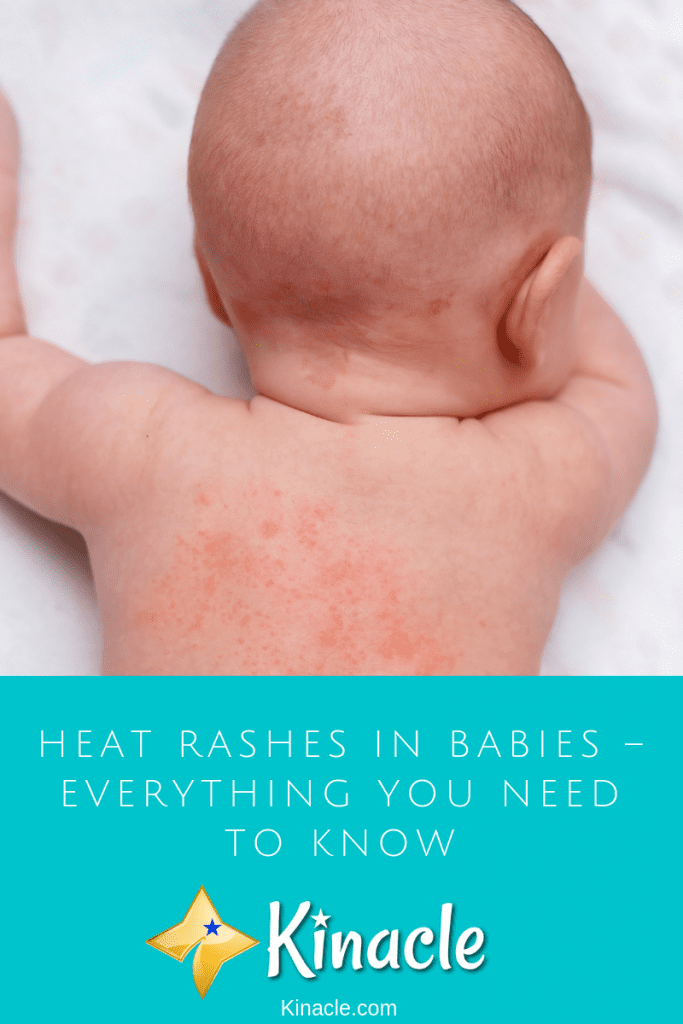
Heat rash is one of the most common rashes in babies. Although it may look worrisome, it’s not actually serious, though it can cause some level of discomfort and itchiness. Therefore, if your little one does develop a heat rash, you’ll want to make sure you treat it to ease their discomfort.
Here, you’ll discover everything you need to know about heat rash in babies, including it’s causes, symptoms and treatments.
What Is Heat Rash And Why Do Babies Get It?
Heat rash is sometimes referred to as prickly heat, and it can affect people of all ages. It occurs when there is excessive sweating which ultimately becomes trapped within the sweat glands. However, as a baby’s sweat glands aren’t fully developed, it makes them more susceptible to experience them.
Their skin is also much more sensitive, increasing the chances a heat rash will occur if they become too warm. Other things that can cause heat rash in babies include tightly-fitting clothing, blankets and swaddles.
There are actually a few different types of heat rash to be aware of. They include:
- Miliaria Ruba
- Miliaria Crystallina
- Miliaria Profunda
The most common type of heat rash is Miliaria Ruba, caused when the sweat glands close to the skin’s surface become blocked. The less serious type of heat rash is Miliaria Crystallina, which occurs when the sweat glands within the epidermis are blocked. Rather than red blisters, this type of rash presents as white or clear blisters.
Finally, Miliaria Profunda is the most serious form of heat rash, caused when sweat leaks from the epidermis into the dermis. This can cause severe burning and flushing, as well as heat exhaustion. There’s the possibility the rash could become infected too so treatment will need to be sought quickly if you suspect this type of rash. The good news is, Miliaria Profunda is very rare so it’s more likely to be one of the lesser serious rashes. However, it’s still worth taking baby to the pediatrician to determine what type of heat rash they are suffering from.
What Are The Symptoms Of Common Heat Rash?
So, how can you tell if your baby is suffering from heat rash? With so many different rashes babies are susceptible to, it can make it difficult to determine which type of rash they’re actually suffering with. However, with heat rashes, the main symptoms typically include:
- Hot skin
- Tiny red bumps
- Restless/Cranky
- Difficulty sleeping
If the skin is hot alongside the small red bumps, it’s likely an indicator of a heat rash. You’ll find it most commonly appears on the face, or within the folds of skin on the arms, neck or upper chest area.
How Can You Treat It?
The majority of heat rashes will clear up by themselves. However, there are some things you can do to ensure baby is more comfortable.
First and foremost, you’ll want to make sure they aren’t too hot. This means, turning the temperature down a little and dressing them in cooler clothing. If baby feels especially hot, you can also place them in a room with the air conditioning on to cool them down. Giving them a bath can also work, provided you use lukewarm water. It has a cooling effect which can also help to calm your little one too. Just be sure to let them air dry and to avoid using soap as this could clog up the pores, causing the rash to become worse.
Throughout the day, a cold compress could also work to ease the symptoms of the rash. Don’t leave it on too long, just use it to temporarily soothe the area. Although it can be tempting to use creams and lotions to try to ease it, these will most likely make the situation worse.
Should You Consult A Doctor?
Although heat rashes do usually clear up within a few days by themselves and are not considered harmful, there are exceptions.
If your little one has a rash for more than three days, or if it seems to be getting worse rather than better, it’s a good idea to take them to see a doctor. If you notice there is swelling or pustules, it could be a sign of a bacterial or yeast infection, which would typically require medication to clear up.
It’s also worth remembering that heat rash doesn’t cause a fever. So, if your baby has a high temperature, that too should be looked at by the doctor as it could indicate another issue.
Conclusion
Overall, heat rash is really common in babies and most of the time, it’s completely harmless. You can follow the tips above to help ease your baby’s discomfort if they do develop one, but don’t forget to take them to the doctor if it isn’t going away within three days. Additionally, if you fear something might be wrong, do not hesitate to seek medical care.
Disclaimer:
This article is for informational purposes only and should not be considered medical advice. Always consult with a doctor or licensed medical professional before making any medical decisions.
Leave a Reply